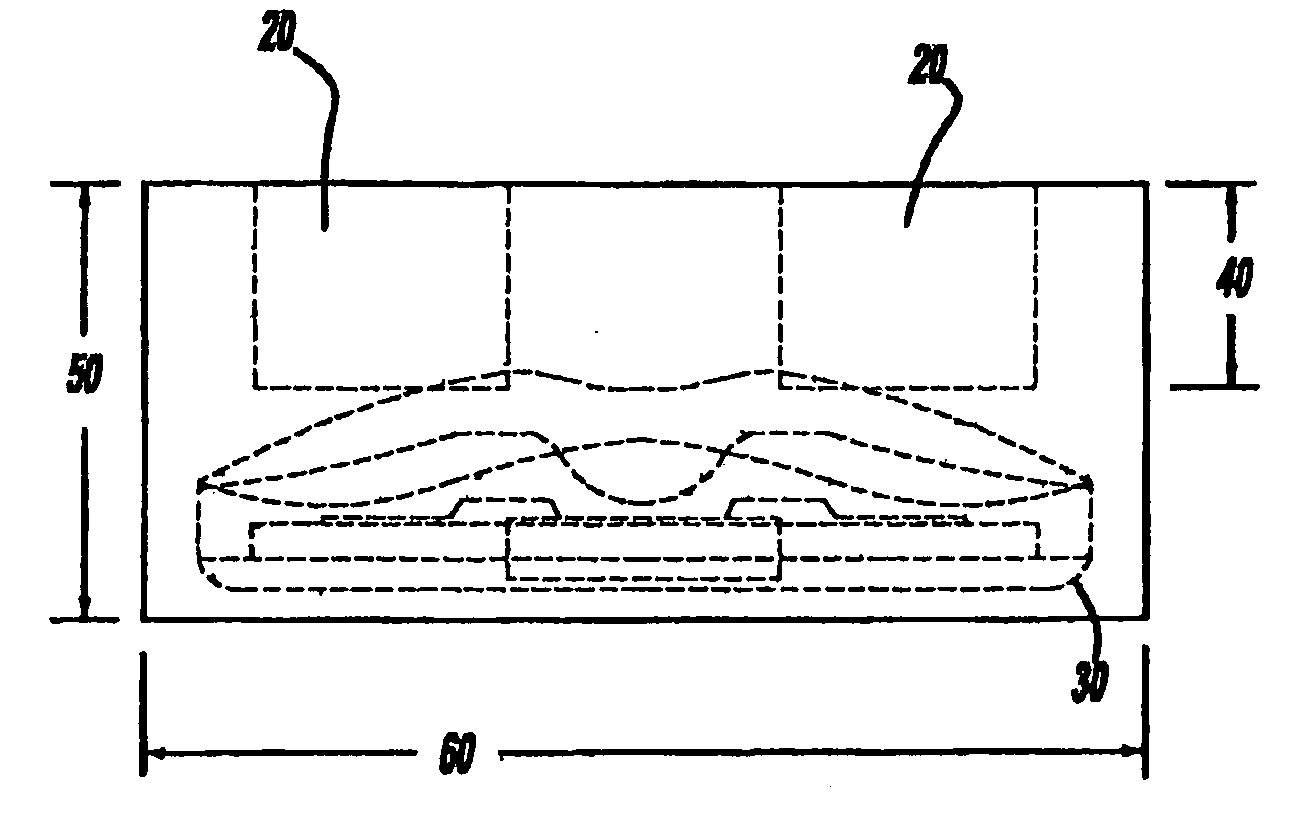Antioxidant doping of crosslinked polymers to form non-eluting bearing components
a crosslinked polymer and antioxidant technology, applied in the field of antioxidant doping of crosslinked polymers, to achieve the effect of improving the oxidation properties of crosslinked materials and increasing wear properties
- Summary
- Abstract
- Description
- Claims
- Application Information
AI Technical Summary
Benefits of technology
Problems solved by technology
Method used
Image
Examples
example 1
[0071]FIG. 1a shows a perspective view of a tibial preform 10 characterized by an overall kidney shape and containing two non-through holes 20. FIG. 1b shows a plan view of the top of the preform 10. Hidden lines indicate schematically the rough position of a tibial bearing 30 to be machined out of the preform 10. FIG. 1c is a plan view showing the depth 40 of the non-through holes 20 and the height 50 and length 60 of the preform 10. FIG. 1d is another side plan view showing the non-through holes 20 and the hidden lines of the tibial bearing 30. FIG. 1e is a perspective of the tibial bearing 30 prepared by machining the preform.
[0072]The views of FIG. 1 illustrate the preform in relation to the implant component machined from it. A line from the surface 70 of the preform to the component 30, when drawn in its shortest length, will be, in various embodiments, 1-15 mm, 1-10 mm, or 1-4 mm in length. Put another way, the outer surface of the component is within 15 mm of the outer surfa...
example 2
[0073]Preparing an implant component involves the following steps:
[0074]An acetabular preform is machined from UHMWPE barstock. A typical preform is shown in FIG. 1a.
[0075]The preform is then cleaned in isopropyl alcohol, placed in a barrier film bag, the bag is placed in a chamber which evacuates the air, purges with argon, evacuates the argon and then seals the package.
[0076]The preforms are then boxed in a double layer and sent for gamma irradiation to a dose of 100±10 kGy.
[0077]When the preforms return, they are removed from the barrier film packaging and doped in vitamin E (dl-α-tocopherol) for 8 hours at 122° C.
[0078]At the end of the doping cycle, the excess vitamin E is cleaned from the surface.
[0079]The preforms are then placed in an inert gas oven and heated to 130° C. and the temperature is held for 264 hours. At the end of the 264 hours, the oven is cooled to room temperature over 6 hours.
[0080]FTIR testing is used to quantify the amount of vitamin E in the polyethylene...
example 3
[0085]Equipment for measuring vitamin E or other antioxidant index includes an FTIR spectrometer, a microtome capable of 200 μm thick slices, an ir microscope with automated stage, and computer software capable of collecting spectra across a sample and creating a profile of peak area ratios for two specific peaks. Measuring the index of a part such as an implant component or a preform involves the following steps:[0086]1. Cut the part such that the area farthest from all surfaces is exposed. This will be the area with the lowest concentration of vitamin E.[0087]2. Use the microtome to make a 200 μm thick slice of the preform. The cut direction is perpendicular to the measurement direction. (The measurement direction is generally the shortest distance between two surfaces that passes through the area with the lowest vitamin E concentration.)[0088]3. Secure the sample to a slotted metal slide with magnets such that the measurement direction is parallel to the slot.[0089]4. Place the s...
PUM
| Property | Measurement | Unit |
|---|---|---|
| temperature | aaaaa | aaaaa |
| temperature | aaaaa | aaaaa |
| temperature | aaaaa | aaaaa |
Abstract
Description
Claims
Application Information
 Login to View More
Login to View More - R&D
- Intellectual Property
- Life Sciences
- Materials
- Tech Scout
- Unparalleled Data Quality
- Higher Quality Content
- 60% Fewer Hallucinations
Browse by: Latest US Patents, China's latest patents, Technical Efficacy Thesaurus, Application Domain, Technology Topic, Popular Technical Reports.
© 2025 PatSnap. All rights reserved.Legal|Privacy policy|Modern Slavery Act Transparency Statement|Sitemap|About US| Contact US: help@patsnap.com



